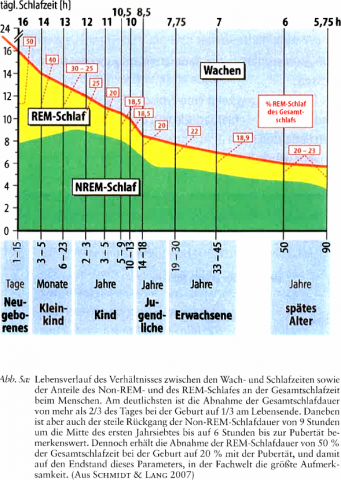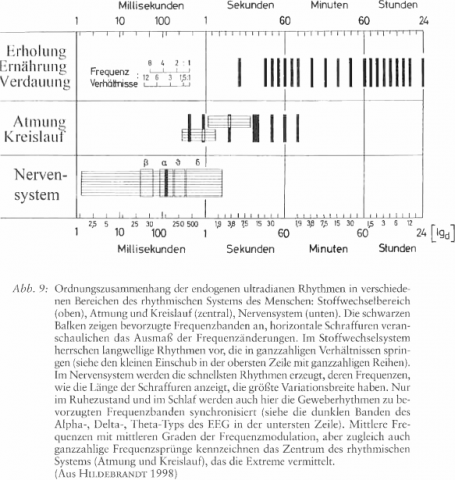Was spricht sich in den Schlafphasen des Menschen aus?
Export Article Citation as
- Download price : €6
Abstract:
What is expressed in a person’s sleeping phases?
Whereas contemporary psychologists and philosophers puzzle over whether there is any such thing as 'consciousness', sleep researchers are in surprising agreement that the human being daily passes through three different forms of consciousness: waking, sleeping, dreaming. But just as modern science in general is helpless regarding the question of 'What is life? ', sleep researchers are unsure why human beings have to sleep. It is clear only empirically that this is so. The discussion presented here reaches the possibly provocative conclusion that the dream state of the human being bears some thoroughly 'psychopathological' traces. Dreamers are deeply involved in their own soul worlds, incapable of self-irony and logic, and in addition are totally cut off from the external physical world, both scnsorially and as regards motor action. But dreamless sleep also has clear 'psychopathological' features as soon as it gains the upper hand, i.e. in cases of prolonged sleep. In comparison the waking state seems to us the psychically most 'normal' form of consciousness. But that it also becomes pathological as soon as it alone exists is confi rmed above all else because people must sleep, otherwise they die. It is true that we still do not know what 'life' is. However, we now have a clearer picture of what is healthy for it: 'health' is the rhythmic alternation of waking, sleeping and dreaming. And this is so even though each of the three individual states has thoroughly pathological features. Thus, health equals rhythm.
References
- BEAR, M. F., CONNORS, B. W, PARADISO, M. A. (Eds.) (2007): Neuroscience — Exploring the Brain. Lippincott Williams & Wilkins, USA. Deutsche Ausgabe herausgegeben von A. K. Engel unter dem Titel: Neurowissenschaften. Ein grundlegendes Lehrbuch für Biologie, Medizin und Psychologie. 3.Aufl. Spektrum Verlag, Heidelberg (2009)
- BIRBAUMER, N., SCHMIDT, R. F. (2006): Biologische Psychologie, 6. Aufl. Heidelberg. Hier insbesondere die Kapitel 20 (Methoden der Biologischen Psychologie) und 22 (Zirkadiane Periodik, Schlaf und Traum)
- HILDEBRANDT, G., MOSER, M., LEHOFER, M. (1998): Chronobiologie und Chronomedizin, ein kurzgefasstes Lehrbuch. Heidelberg
- PURVES, D. & al. (Eds.) (2008): Neuroscience. Hier insbesondere Kapitel 28 (Sleep and Wakefulness). Sinauer Associates, Sunderland
- RECHTSCHAFFFN, A., KALES, A. (Eds.) (1968): A manual of standardized terminology, techniques and scoring systems. U.S. Dept. Health, Education and Welfare, National Institute of Health Publ. No. 204. Washington
- SCHMIDT, R. F., LANG, F. (Hrsg.) (2007): Physiologie des Menschen mit Pathophysiologie. Hier insbesondere Kap. 9 (Wachen, Aufmerksamkeit und Schlafen). Heidelberg
- SCHMIDT, R. F., SCHAIBLE, H.-G. (Hrsg.) (2006): Neuro- und Sinnesphysiologie, 5. Aufl. Heidelberg. Hier insbesondere Kapitel 16 (Wachen, Aufmerksamkeit und Schlafen)
- ZSCHOCKE, S. (2002): Klinische Elektroeruephalographie. Heidelberg, New York. Hier insbesondere die Kapitel 4 (Die Grundaktivität des normalen EEG) und 5 (Vigilanz und Schlaf)
- AESCHBACH, D. (21109): Slow Waves and Learning: Beyond Correlations. SLEEP 32: 1253-1254
- ÅKERSTEDT, T., KECKLUND. G., INGRE. M. & al. (2009): Sleep homeostasis during repcnted sleep restriction and recovery: support from EEG dynamics. SLEEP 32(2): 217-222
- ASERINSKY, E., KLEITMAN, N. (1953): Regularly occurring periods of eye motility, and concernitant phenomena during sleep. Science 118: 273-274
- BORBELY, A. A., BAU MANN, F., BRANDEIS, D. & al. (1981): Sleep deprivation: effects on sleep stages and EEG power density in man. Electroencephalogr. Clin. Neurophysiol. 51: 483-493
- BORN, J. (2010): Wie man Schlaf gezielt einsetzen kann. Spiegel Online vom 8. Mai 2010
- BÜTTNER, G, HENSEL, H. & al. (Hrsg.) (1977): Biologische Medizin: Grundlagen ihrer Wirksamkeit. Heidelberg
- DEMENT,W. C., KLEITMAN, N. (1957): Cyclic variations in EEG during sleep and their relations to eye movements, body motility and dreaming. Electroenceph. Clin. Neurophysiol. 9: 673-690
- GENZEL, L. & al. (2009): Slow wave sleep and REM sleep awakenings do not affect dependent memory consolidation. SLEEP 32(3): 302-310
- GLÖCKI.ER, G. (1981): Zur Menschenkunde der Oberstufe. Als Manuskriptdruck Pädagogischen Forschungsstelle Stuttgart, hrsg. von W Schad
- GOETHE, J. W. (1808-1831): Aus meinem Leben. Dichtung und Wahrheit, 4. Teil, 16. Buch
- GROTE, I. R. ( 1961): Der Arzt in Angesicht von Leben, Krankheit und Tod. Hippokrates Verlag, Stuttgart
- GUTENBRUNNER, C. (2003): Hygiogenese und Salutogenese — Versuch einer (notwendigen) Begriffsdifferenzierung. Tycho de Brahe-Jahrbuch für Goetheanismus 2003: 38-49. Niefern«Öschelbronn
- HENSEL, H. (1977): Die natürliche Selbstheilung des menschlichen Organismus und die moderne Naturwissenschaft. Universitas 32: 951-960
- HILDEBRANDT, G. (1967): Die Koordination rhytmischer Funktionen beim Mensd1en. Dtsch. Ges. Inn. Med. 73: 922-941
- HILDEBRANDT, G. (1977): Hygiogenese. Grundlinien einer therapeutischen Physiologie. Therapiewoche 27: 5384-5397
- HILDEBRANDT, G. (1980): Chronobiologische Grundlagen der Ordnungstherapie. In: Brüggemann (Hrsg.), Kneipp-Therapie. Ein Lehrbuch, S. 211. Berlin
- HILDEBRANDT, G. (1986): Zur Physiologie des rhythmischen Systems. Beiträge zu einer Erweiterung der Heilkunst 39: 8-30
- HILDEBRANDT, G. (1993): Zeiterleben und Zeitorganismus des Menschen: In: Kniebe, G. (Hrsg.), Was ist Zeit?, S. 173. Stuttgart
- HILDEBRANDT, G. (1999): Physiologische Grundlagen der Hygiogenese. ln: Heusser, P. (Hrsg.), Akademische Forschung in der Anthroposophischen Medizin, S. 57-82. Bern
- HOFF, F. (1957): Fieber, unspezifische Abwehrvorgänge, unspezifische Therapie. Stuttgart
- HORNE, J. (2008): New Scientist, 18.10.2008, pp. 37-38
- KRIPKE, D. F., GARFINKEL, L., WINGARD, D. L. & al. (2002): Mortality associated with sleep duration and insomnia. Arch. Gen. Psychiatry 59: 131-136
- LOOMIS, A. L., HARVEY, E. N., HOBART, G. (1936): Electrical potentials of the human brain. J. Exp. Psychol. 19: 249-279
- SCHAD, W. ( 1978): Das Problem der Mitte. Mitteilungen aus der anthroposophischen Arbeit in Deutschland 125: 185-194. Stuttgart
- SCHAD, W. (2003): Chronobiologie ist Ätherforschung. Tycho de Brahe-Jahrbuch für Goetheanismus 2003: 20-36. Niefern-Öschelbronn
- SOLMS, M. (2009): Voller Emotionen und Instinkte. Interview in SPIEGEL WISSEN 4/2009: 105-117
- STEINER, R. (1906): Zeichen und Symbole des Weihnachtsfestes. In: Ursprungsimpulse der Geisteswissenschaft (GA 96), Vortr. v. 17.12.1906. Dornach (1983)
- STEINER, R. (1917): Von Seelenrätseln (GA 21). IV. Skizzenhafte Erweiterungen dieser Schrift. 6. Die physischen und geistigen Abhängigkeiten der Menschen-Wesenheit. 5 . Aufl. Dornach (1983)
- STEINER, R. (1920): Entsprechungen zwischen Mikrokosmos und Makrokosmos. Der Mensch-eine Hieroglyphe des Weltalls (GA 201). Dornach
- STEINER, R. (1921): Geisteswissenschaftliche Gesichtspunkte zur Therapie (GA 313), 8. Vortrag 3. Aufl. Dornach (1963)
- STEINER, R. (1922a): Physiologisch-Therapeutisches auf Grundlage der Geisteswissenschaft (GA 314). Zwölf Vorträge, ein Votum, eine Ansprache und zwei Besprechungen mit Ärzten in Dornach und Stuttgart. Vortr. vom 27.10.1922 in Dornach. 2. Aufl. Dornach (1975)
- STEINER, R. (1922b): Die Schlaferlebnisse des Menschen, ihre geistigen Hintergründe und ihre Bedeutung für das Tagesleben. In: Geistige Zusammenhänge in der Gestaltung des menschlichen Organismus (GA 218), 1. Vortr. vom 9.10.1922, S. 22. 2. Aufl. Dornach (1976)
- STEINER, R. (1923): Der Mensch als Bild geistiger Wesen und geistiger Wirksamkeiten. Vortr. vom 2.9.1923 in London. In: lnitiationswissenschaft und Sternenerkenntnis (GA 228). Dornach (1964)
- STEINER, R. (1925): Anthroposophische Leitsätze (GA 26). Leitsätze Nr. 156-158, S. 206. 6. Aufl. Dornach (1972)
- STUART, K., CONDUIT, R. (2009): Auditory inhibition of rapid eye movements and dream recall from REM sleep. SLEEP 32(3): 399-408
- WAGNER, U., BORN, J. (2008): Memory consolidation during sleep: interactive effects of sleep stages and HPA regulation. Stress 11(1): 28-41
- WALKER, M. P. (2009): The role of sleep in cognition and emotion. Ann. N. Y. Acad. Sci. 1156: 168-197
- WEBB, W. B., AGNEW, J. H. W. (1965): Sleep: effects of a restricted regime. Science 150: 1745-1747
- WEBB, W. B., AGNEW, J. H. W. (1971): Stage 4 sleep: influence of time course variables. Science 174: 1354-1356




















